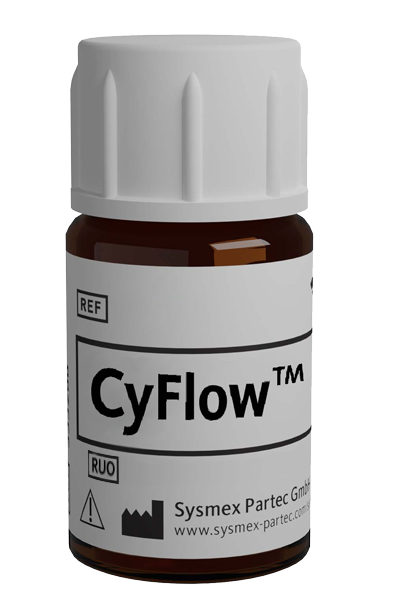CyFlow™ CD63 PerCP

| Alternative Name: | LAMP-3, LIMP , MLA1 |
| Antibody: | Yes |
| Antigen: | CD63 |
| Application: | Flow cytometry |
| Clonality: | monoclonal |
| Clone: | MEM-259 |
| Emission Maximum: | 678 nm |
| Excitation Maximum: | 482 to 490 nm |
| Field of Interest: | Endocytosis, Immunophenotyping |
| Format/Fluorochrome: | PerCP |
| Isotype: | IgG1 |
| Laser: | Blue , Green |
| Regulatory Status: | RUO |
| Source Species: | Mouse |
| Target Species: | Human |
| Product number: | BP806651 |
For Research Use Only
| Quantity | 100 tests |
| Volume | 1.0 mL |
| Immunogen | Human Acute Lymphocytic Leukemia (ALL) T cells |
| Background Information | CD63 (LAMP-3; lysosome-associated membrane protein-3), a glycoprotein of tetraspanin family, is present in late endosomes, lysosomes and secretory vesicles of various cell types. It is also present in the plasma membrane, usually following cell activation. Hence, it has become an widely used basophil activation marker. In mast cells, however, CD63 exposition does not need their activation. CD63 interacts with integrins and affects phagocytosis and cell migration, it is also involved in H/K-ATPase trafficking regulation of ROMK1 channels. CD63 also serves as a T-cell costimulation molecule. Expression of CD63 can be used for predicting the prognosis in earlier stages of carcinomas. |
| Usage | The reagent is designed for Flow Cytometry analysis of human blood cells. Recommended usage is 10·µl reagent·/ 100·µl of whole blood or 10^6 cells in a suspension. The content of a vial (1 ml) is sufficient for 100 tests. |
| Storage Buffer | The reagent is provided in stabilizing phosphate buffered saline (PBS) solution, pH ≈7.4, containing 0.09% (w/v) sodium azide. |
| Storage | Avoid prolonged exposure to light. Store in the dark at 2-8°C. Do not freeze. |
| Stability | Do not use after expiration date stamped on vial label. |
| Mantegazza AR, Barrio MM, Moutel S, Bover L, Weck M, Brossart P, Teillaud JL, Mordoh J: CD63 tetraspanin slows down cell migration and translocates to theendosomal‑lysosomal‑MIICs route after extracellular stimuli in human immature dendritic cells. Blood. 2004 Aug 15; 104(4):1183‑90. < PMID: 15130945 > | Cerny J, Feng Y, Yu A, Miyake K, Borgonovo B, Klumperman J, Meldolesi J, McNeil PL, Kirchhausen T: The small chemical vacuolin‑1 inhibits Ca(2+)‑dependent lysosomal exocytosis but not cell resealing. EMBO Rep. 2004 Sep; 5(9):883‑8. < PMID: 15332114 > | Grützkau A, Smorodchenko A, Lippert U, Kirchhof L, Artuc M, Henz BM: LAMP‑1 and LAMP‑2, but not LAMP‑3, are reliable markers for activation‑induced secretion of human mast cells. Cytometry A. 2004 Sep; 61(1):62‑8. < PMID: 15351990 > | Pfistershammer K, Majdic O, Stöckl J, Zlabinger G, Kirchberger S, Steinberger P, Knapp W: CD63 as an activation‑linked T cell costimulatory element. J Immunol. 2004 Nov 15; 173(10):6000‑8. < PMID: 15528334 > | Israels SJ, McMillan-Ward EM: CD63 modulates spreading and tyrosine phosphorylation of platelets on immobilized fibrinogen. Thromb Haemost. 2005 Feb; 93(2):311‑8. < PMID: 15711748 > | Kwon MS, Shin SH, Yim SH, Lee KY, Kang HM, Kim TM, Chung YJ: CD63 as a biomarker for predicting the clinical outcomes in adenocarcinoma of lung. Lung Cancer. 2007 Jul; 57(1):46‑53. < PMID: 17350713 > | Lin D, Kamsteeg EJ, Zhang Y, Jin Y, Sterling H, Yue P, Roos M, Duffield A, Spencer J, Caplan M, Wang WH: Expression of tetraspan protein CD63 activates protein tyrosine kinase (PTK) and enhances the PTK‑induced inhibition of ROMK channels. J Biol Chem. 2008 Jan 22; < PMID: 19880522 >
